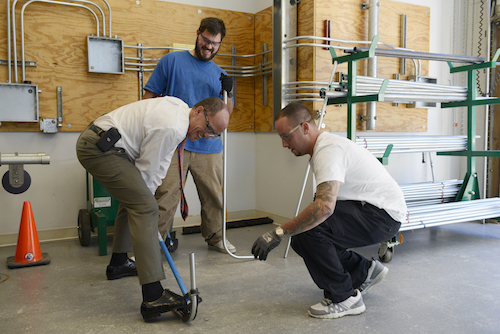The third annual National Apprenticeship
Week kicked off Nov. 13, marked by apprenticeship graduations, training center
open houses and other events highlighting the benefits of on-the-job training.

|
| Former Secretary of Labor Tom Perez celebrated the inaugural National Apprenticeship Week at Washington, D.C., Local 26's training facility in Lanham, Md. Above, a Local 26 apprentice teaches Perez to bend conduit during his visit.
|
“National Apprenticeship Week is a great opportunity for us to remind young people – or folks looking for a new career – of the benefits of getting paid to learn a trade,” said International President Lonnie R. Stephenson. “At a time when the average college student graduates more than $25,000 in debt, we’re proud to offer an alternative path to the middle class.”
The week, which started in 2015 under then-president Barack Obama’s Department of Labor, highlights the advantages of both union and nonunion apprenticeships and allows companies, trade and industry groups, nonprofit organizations, unions, labor-management organizations and educational institutions a chance to highlight how apprenticeship programs can address the nation’s skills gap.
It’s unions and contractor partners who do much of the hard work of training American’s next generation of tradesmen and tradeswomen. Together, North America’s Building Trades unions and contractor partners invest $1.3 billion each year at more than 1,900 training centers across the U.S., training more working people than any organization except the federal government.
According to a new study from the AFL-CIO and Jobs With Justice, workers who complete apprenticeships programs earn more than $300,000 more than their peers over a lifetime. The researchers also found that the wage gap between workers with a college degree and those without a degree increased to 57 percent in 2016, further emphasizing the need for workers without degrees to take steps to increase their earning power.
Earlier this year, Folsom, N.J., Local 351 member, Rep. Donald Norcross, introduced a bill in the U.S. House of Representatives to boost on-the-job education by helping apprentices pay for the tools and learning materials required by their training programs. The legislation would make saving easier by opening up tax-advantaged “529” college savings plans to apprenticeship expenses, not just traditional academic institution costs.
“An apprenticeship program shaped my life – taking me from community college to construction work to Congress,” Norcross said. “Education and job training is not one-size-fits-all – and the rules for savings plans should reflect that truth.”
With the U.S. – and the electrical industry in particular – facing a skilled worker shortage in the coming decades, several IBEW locals are taking advantage of the opportunity to publicize their training programs and boost interest in a career in the electrical trade.
At Portland, Maine, Local 567, Business Manager Jim Valente says his local is drumming up interest in the training program as well as educating the public about opportunities for good careers outside of the college route many high school students are pushed toward.
“It’s an opportunity for us to showcase our training facility and our program here,” Valente said of two open house events Local 567 is hosting on Nov. 15 and Nov. 18. “We’re proud of it, and we’re excited to show it off.”
Valente’s apprenticeship director, Allan Shepard, said the event on Wednesday will bring guidance counselors, career and technical educators and instructors from local vocational high schools to the training center, and that Saturday’s event will feature more of a fun program for the members and general public. “We’ll have apprentices doing pipe-bending demonstrations and a skills competition,” he said, “and we hope some of these instructors will bring their juniors and seniors out to learn more about a career in the IBEW.”

|
| New apprentices from Salt Lake City Local 354 graduated as part of a National Apprenticeship Week celebration on Nov. 10.
|
In Utah, Salt Lake City Local 354 hosted its annual apprenticeship graduation on Nov. 10. The Utah Electrical Joint Apprenticeship Training Committee graduated 75 members at the event: 67 journeyman inside wiremen and eight telecommunications technicians.
“I always try to look for a day that coincides with National Apprenticeship Week,” said Training Director Carl Brailsford. “It’s a great opportunity to highlight the value of apprenticeships, even here in a market where there’s no shortage of great applicants.”
The average age of a first-year apprentice at Local 354 is 27, Brailsford said, and a lot of them already have academic degrees – and student debt. “They’re not going to add any more to that here,” he said. “The old ‘earn while you learn,’ precept still applies, and these applicants know they’ll leave here with a career they can be proud of.”
The graduation event was sponsored by the local’s labor-management cooperation committee and attended by industry types from employers and vendors to Local 354 members and families. “Word of mouth is still the No. 1 way applicants find out about the program, so events like these are important,” Brailsford said. The local is also participating in a career fair of registered apprenticeship programs at the Utah Department of Workforce Services later in the week.
Locals with events being held during National Apprenticeship Week are encouraged to register them on the Department of Labor’s website and to start thinking about events they could host during next year’s event.
Women in Apprenticeship Day is Nov.
16 and specifically calls attention to the need for more representation by
women in the trades. Participants are encouraged to post to social media using
the hashtags, #WomenInApprenticeship and #Tradeswomen to raise awareness.